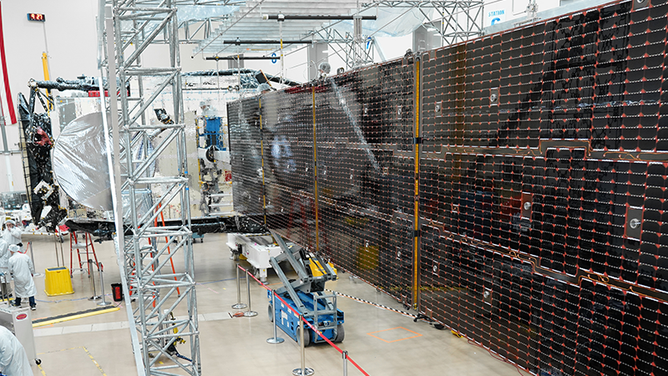Clouds part ways for SpaceX to launch a Falcon Heavy rocket from Florida's Space Coast
Before NASA's Space Launch System rocket launch to the Moon last year, Falcon Heavy was the world's most powerful rocket. The Falcon Heavy has 27 Merlin engines and three first-stage boosters compared to SpaceX's Falcon 9 rocket, with one first-stage booster and nine Merlin engines.
SpaceX launches a Falcon Heavy rocket from Florida
Under the occasional cloudy sky, SpaceX launched a Falcon Heavy rocket with a giant communications satellite from Florida on Friday.
KENNEDY SPACE CENTER, Fla. – The second attempt to launch a Falcon Heavy rocket from Florida's Space Coast was a success on Friday evening, with clouds providing enough clearance for the school-bus-sized satellite to reach outer space.
The company originally tried to launch the payload on Wednesday but scrubbed the attempt less than 2 minutes before liftoff "due to a violation of abort criteria."
Before NASA's Space Launch System rocket launch to the Moon last year, Falcon Heavy was the world's most powerful rocket. The Falcon Heavy has 27 Merlin engines and three first-stage boosters compared to SpaceX's Falcon 9 rocket, with one first-stage booster and nine Merlin engines.
About 8 minutes after launch, the two side rocket boosters returned to Cape Canaveral Landing Zones 1 and 2.
What did Falcon Heavy launch?

The Jupiter 3 solar arrays span ten stories once unfolded in space. (Image credit: Hughes)
According to the satellite operator Hughes, Jupiter 3 will support in-flight Wi-Fi, maritime communications and HughesNet satellite internet connectivity across North and South America.
SpaceX's heavy-lift rocket is designed for larger payloads. Jupiter 3 is a massive spacecraft weighing about 9 metric tons with 14 solar panels that span 10 stories.
The satellite was built by Maxar in Palo Alto, California, before being carried by a special Antonov commercial cargo plane to Cape Canaveral. The nose of the plane hinges open for large cargo to be loaded up.
